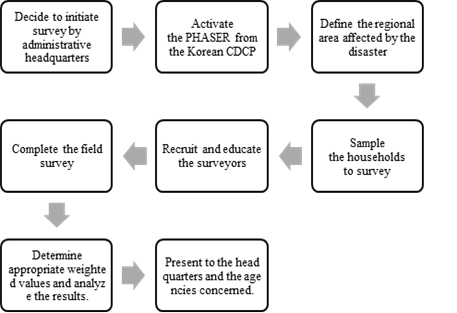1. Shultz JM, Russell J, Espinel Z. Epidemiology of tropical cyclones: the dynamics of disaster, disease, and development. Epidemiol Rev. 2005; 27:21–35.
2. Korteweg HA, van Bokhoven I, Yzermans CJ, Grievink L. Rapid health and needs assessments after disasters: a systematic review. BMC Public Health. 2010; 10:295.
3. Quinlisk P, Jones MJ, Bostick NA, Walsh LE, Curtiss R, Walker R, Mercer S, Subbarao I. Results of rapid needs assessments in rural and urban Iowa following large-scale flooding events in 2008. Disaster Med Public Health Prep. 2011; 5:287–292.
4. Babaie J, Moslehi S, Ardalan A. Rapid health needs assessment experience in 11 August 2012 East Azerbaijan earthquakes: a qualitative study. PLoS Curr. 2014; 6:ecurrents.dis.308f6140d54f78fd1680e2b9e6460ae3.
5. Centers for Disease Control and Prevention (CDC). Tropical Storm Allison rapid needs assessment--Houston, Texas, June 2001. MMWR Morb Mortal Wkly Rep. 2002; 51:365–369.
6. Bayleyegn T, Wolkin A, Oberst K, Young S, Sanchez C, Phelps A, Schulte J, Rubin C, Batts D. Rapid assessment of the needs and health status in Santa Rosa and Escambia counties, Florida, after Hurricane Ivan, September 2004. Disaster Manag Response. 2006; 4:12–18.
7. Centers for Disease Control and Prevention (CDC). Rapid community needs assessment after Hurricane Katrina--Hancock County, Mississippi, September 14–15, 2005. MMWR Morb Mortal Wkly Rep. 2006; 55:234–236.
8. Güereña-Burgueño F, Jongsakul K, Smith BL, Ittiverakul M, Chiravaratanond O. Rapid assessment of health needs and medical response after the tsunami in Thailand, 2004–2005. Mil Med. 2006; 171:8–11.
9. Centers for Disease Control and Prevention (CDC). Assessment of household preparedness through training exercises--two metropolitan counties, Tennessee, 2011. MMWR Morb Mortal Wkly Rep. 2012; 61:720–722.
10. Horney J, Davis MK, Davis SE, Fleischauer A. An evaluation of community assessment for public health emergency response (CASPER) in North Carolina, 2003–2010. Prehosp Disaster Med. 2013; 28:94–98.
11. Nyaku MK, Wolkin AF, McFadden J, Collins J, Murti M, Schnall A, Bies S, Stanbury M, Beggs J, Bayleyegn TM. Assessing radiation emergency preparedness planning by using community assessment for public health emergency response (CASPER) methodology. Prehosp Disaster Med. 2014; 29:262–269.
12. Bayleyegn TM, Schnall AH, Ballou SG, Zane DF, Burrer SL, Noe RS, Wolkin AF. Use of community assessments for public health emergency response (CASPERs) to rapidly assess public health issues - United States, 2003–2012. Prehosp Disaster Med. 2015; 30:374–381.
13. Ylitalo KR, Umstattd Meyer MR, Stone K, Doyle EI, Curtis R. Using the community assessment for public health emergency response (CASPER) to assess barriers to healthy eating and active living in a low-income community. Eval Program Plann. 2016; 59:41–46.
14. Shultz JM, Marcelin LH, Madanes SB, Espinel Z, Neria Y. The “Trauma Signature:” understanding the psychological consequences of the 2010 Haiti earthquake. Prehosp Disaster Med. 2011; 26:353–366.
15. North CS, Pfefferbaum B, Hong BA, Gordon MR, Kim YS, Lind L, Pollio DE. Workplace response of companies exposed to the 9/11 World Trade Center attack: a focus-group study. Disasters. 2013; 37:101–118.
16. Munir K, Ergene T, Tunaligil V, Erol N. A window of opportunity for the transformation of national mental health policy in Turkey following two major earthquakes. Harv Rev Psychiatry. 2004; 12:238–251.
17. Everly GS Jr, Barnett DJ, Links JM. The Johns Hopkins model of psychological first aid (RAPID-PFA): curriculum development and content validation. Int J Emerg Ment Health. 2012; 14:95–103.
18. Wang PC, Mwango A, Moberley S, Brockman BJ, Connor AL, Kalesha-Masumbu P, Mutembo S, Bweupe M, Chanda-Kapata P, Biemba G, et al. A cluster randomised trial on the impact of integrating early infant HIV diagnosis with the expanded programme on immunization on immunization and hiv testing rates in rural health facilities in Southern Zambia. PLoS One. 2015; 10:e0141455.
19. Muloiwa R, Kagina BM, Engel ME, Hussey GD. The burden of pertussis in low- and middle-income countries since the inception of the Expanded Programme on Immunization (EPI) in 1974: a systematic review protocol. Syst Rev. 2015; 4:62.
20. Machingaidze S, Wiysonge CS, Hussey GD. Strengthening the expanded programme on immunization in Africa: looking beyond 2015. PLoS Med. 2013; 10:e1001405.
21. Kim SJ, Kim CH, Shin SD, Lee SC, Park JO, Sung J. Incidence and mortality rates of disasters and mass casualty incidents in Korea: a population-based cross-sectional study, 2000–2009. J Korean Med Sci. 2013; 28:658–666.









 PDF
PDF ePub
ePub Citation
Citation Print
Print




 XML Download
XML Download